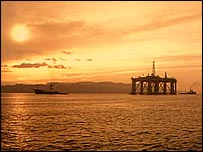I found the following article at: Hydropolis - The World's First Underwater Hotel
I have not had the opportunity to verify it with additional sources. However I thought many may find it interesting.
Currently under construction in Dubai, Hydropolis is the world's first luxury underwater hotel. It will include three elements: the land station, where guests will be welcomed, the connecting tunnel, which will transport people by train to the main area of the hotel, and the 220 suites within the submarine leisure complex. Great photos.It is one of the largest contemporary construction projects in the world, covering an area of 260 hectares, about the size of London's Hyde Park.
"Hydropolis is not a project; it's a passion," enthuses Joachim Hauser, the developer and designer of the hotel. His futuristic vision is about to take shape 20m below the surface of the Arabian Gulf, just off the Jumeirah Beach coastline in Dubai. The £300 million, 220-suite hotel is due to open at the end of 2007 and will incorporate a host of innovations that will take it far beyond the original blueprint for an underwater complex worthy of Jules Verne.
There are only a few locations in the world where such a grandiose dream could be realised. A high proportion of today's architectural marvels are materialising like fanciful mirages from the desert sands. We have come to expect extravagant enterprises to be mounted in the Middle East, and especially in Dubai. "This venture could only be born here in Dubai," says Hauser. "It [has] a very open-minded, international community - and that's what makes it so special."
The land on which Hydropolis is being built belongs to His Highness General Sheikh Mohammed Bin Rashid Al Maktoum, Crown Prince of Dubai. It was his last free beach property on this stretch of coast. The project is a fantastic one, yet Sheikh Mohammed's success record with comparable schemes instils confidence that science fiction can become fact. With his support, several companies have been formed to kick-start this phenomenal project, and around 150 firms are currently involved.
"There have been many visions of colonising the sea - Jules Verne, Jean Gusto and several Japanese architects - but no one has ever managed to realise this dream," says Hauser. "That was the most challenging factor, and that's what makes it so fascinating. Despite being a dream of mankind for centuries, nobody has ever been able to make living underwater possible."
UNDERWATER HOTEL DESIGN
The original idea for Hydropolis developed out of Hauser's passion for water and the sea, and goes much deeper than just building a hotel underwater. More than just curiosity, it is a commitment to a more far-reaching philosophy. "Once you start digging deeper and deeper into the subject, you can't help being fascinated and you start caring about all the associated issues," he explains. "Humans consist of 80% water, the earth consists of 80% water; without water there is no life."
Hydropolis reproduces the human organism in an architectural design. There is a direct analogy between the physiology of man and the architecture. The geometrical element is a figure eight lying on its side and inscribed in a circle. The spaces created in the basin will contain function areas, such as restaurants, bars, meeting rooms and theme suites. These can be compared to the components of the human organism: the motor functions and the nervous and cardiovascular systems, with the central sinus knot representing the pulse of all life.
The ballroom, located at this nerve centre, will have asymmetrical pathways connecting the different storeys along ramps. A large, petal-like retracting roof will enable the staging of open-sky events. Staircases, lifts and ramps will provide access to the ballroom, while flanking catering areas will supply banquets and receptions.
HYDROPOLIS LAND STATION
In order to enter this surreal space, visitors will begin at the land station. This 120m woven, semicircular cylinder will arch over a multi-storey building. On the lowest level passengers board a noiseless train propelled by fully automated cable along a modular, self-supporting steel guideway to Hydropolis. A just-in-time and on-demand logistical system will facilitate efficient supply of goods to the hotel.
The upper storeys of the land station house a variety of facilities, including a cosmetic surgical clinic, a marine biological research laboratory and conference facilities. On the lower levels are the staff rooms, goods storage and loading areas, and hotel and parking areas.
The land station also includes a restaurant and high-tech cinema screening the evolution of life in the ocean and the history of underwater architecture. As a finale, the screen will open to reveal the real-life Hydropolis. A viewing platform at the front opening of the spanning roof will allow views of the architecture as well as the light shows of Hydropolis.
MARINE ARCHITECTURE
This structure promises to be a conceptual as well as a physical landmark. While human beings accept the existence of water, we have only a superficial appreciation of its significance. "We waste it, go swimming in it and generally take it for granted," says Hauser. "Humans could actually live self-sufficiently underwater, generating energy, nurturing food supplies and so on. This is why we are starting a foundation to demonstrate something of the importance of water in our lives.
"My general plan was to create a living space in the sea. My initial proposal was a deep-sea project, which looked very different. I had to adjust to the local reality of the natural surroundings and change to a shallow water construction.
"We want to create the first ever faculty for marine architecture because I believe that the future lies in the sea, including the future of city planning. I am certain that one day a whole city will be built in the sea. Our aim is to lay the first mosaic by colonising the sea."
Hauser plans to incorporate many different elements associated with the sea. The cosmetics will be ocean-based, the cinemas will screen films that focus on aquatic themes and a children's seaworld will educate as well as entertain.
He views his creation as a place where those who do not dive - or do not even swim - can experience the tranquillity and inspiration of the underwater world. "We are expecting around 3,000 visitors per day in addition to the hotel guests. The aim is to inspire people to develop a new awareness of the sea."
As well as emphasising the positive aspects of water, Hauser also believes we are systematically destroying marine life, and thus wishes to draw attention to various dangers and problems, such as the loss of algae and the destruction of the coral reefs.
FUNDING AND DEVELOPMENT
Dreams, however fabulous, remain unfulfilled without the cash to support the commitment. "The hardest part of the process was finding sponsorship to the tune of €550 million," admits Hauser. "That's what brought me to Dubai. Still, it was a battle which took two-and-a-half years and proved tougher than developing the project itself. No bank would pay such an amount. It's a risky investment, as there are no pilots. We had to convince investors that it is safe and will bring returns on investment."
With official blessing, the Dubai Development & Investment Authority (DDIA) established a framework to handle grants and authorisations. Once the financial backing was guaranteed, the sonar analysis of the seabed complete and 7,000 anchors in place, construction began in summer 2005.
"We are sure that this hotel will set a precedent," says Hauser. "Crescent-Hydropolis is now planning a chain of underwater hotels, and nine countries have shown interest. Some will be the realisation of my initial deep-sea design." Hauser has even chosen to make his permanent home in Dubai. "And that won't change after the project [is finished], regardless of where our next project will be. The infrastructure is exceptionally good here - and it seldom rains!"
To see what it will look like, follow this link: Hydropolis - The World's First Underwater Hotel

















